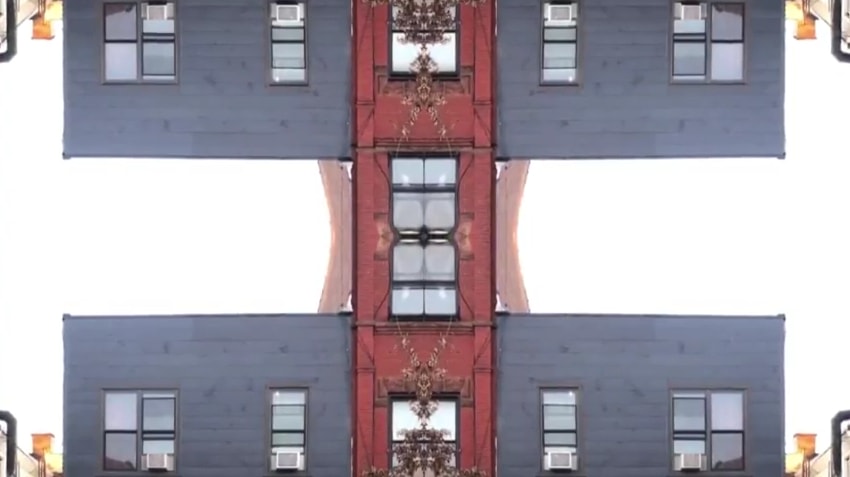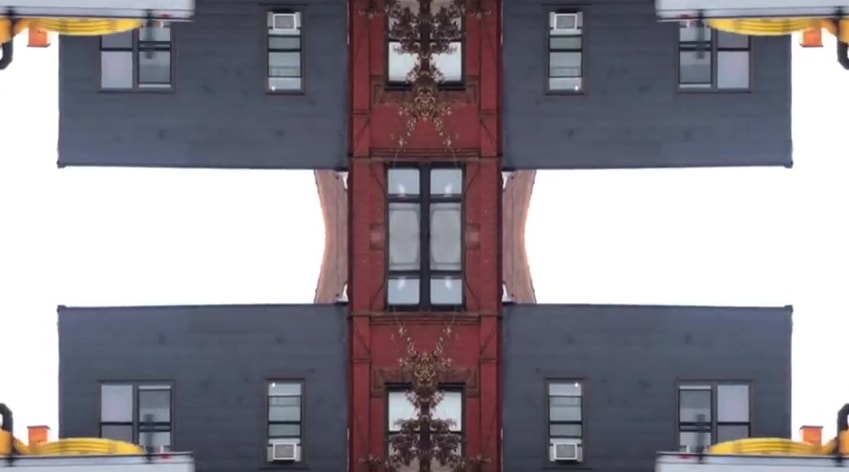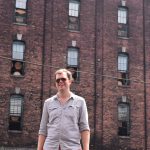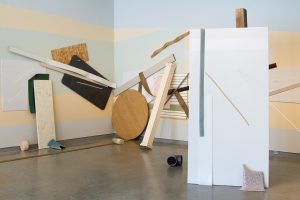I. GROUND CONTROL
Timothy Winkelman’s digital video, Unplanned, immediately vexes the viewer with a question: what, exactly, is unplanned about Unplanned? Due in no small part to its infinitesimal scope – the video doesn’t quite reach a full minute in length, and lingers on visual and musical subjects that could easily be overlooked – one could be forgiven for focusing less on immersing themself in the work’s content and more on the confluence of formal planning that underpins a video production. But upon repeated viewings, Winkelman’s camera lets something else appear: a subtle commentary on the desire to shape a space into a dwelling where one may Be in the World.
The video never detaches its gaze from an urban scene: a modern building – perhaps an apartment complex – alongside a city street. We quickly see that this is a very built environment, quite the opposite of an “unplanned” setting. The city, particularly in its American grid form, constitutes perhaps the height of planning. Urbanity is the coordination of intent and execution, subjugation of nature and neighbor, and organization of materials and labor in order to create the largest collection of shelters possible. Unplanned’s world, then, borrows the uncompromising architectural forms of modernity: inflexible geometry, material abundance (or, the delusion thereof), serial repetition, and cut-and-paste symmetries.
http://https://youtu.be/QoyOyvm_4yA
Timothy Winkelman, “Unplanned,” 2018. In this 54-second digital video, a street shot of a slate-gray building and a red brick building is mirrored in each quadrant, creating a kaleidoscope-like effect. Video courtesy of the artist.
This world is supported by Winkelman’s frugal digital toolkit. Here, his point-shoot-edit-upload aesthetic has the deskilled appeal of a bedroom music video. In place of a diegetic soundtrack, a repetitive, two-chord trap beat loops with the suggestion that hip hop has supplanted the automobile (and before it, the light rail, and before it, the rabbling crowd) as the definitive urban soundscape. The video footage is horizontally and vertically mirrored to produce symmetrical quadrants. This quietly roaming, improvisational camera work explores emergent symmetries.
In parsimony and approach, Winkelman’s piece is akin to Steina Vasulka’s early video experimentation, such as Summer Salt (1982). Vasulka championed the simple act of turning the clumsy video camera onto humble surroundings to find out what we are otherwise unable to see in them. By augmenting her camera with idiosyncratic lenses, filters, or synthesizers, she unveiled the unique ability of video to document the world while simultaneously expanding our perception of it.
In Winkelman’s words, “As part of a larger series Glitch, [Unplanned] is an exploration in randomness, seeking to manipulate and change our architectural spaces in an effort to control them.” Rather than adopting a drafting pencil and blueprints, Winkelman uses his video and effects to create impossible architecture. Through his mirroring effect, minor artefacts of an imprecise hand morph the wood and stone in ways that an engineer cannot. Before our eyes, the building kaleidoscopically grows, then shrinks, then bends – like a piece of architectural origami.
Winkelman states that his video “takes hold of the architecture and manipulates it to create an area of calm.” Where Vasulka’s play is full of manic, childlike energy – occasionally exhausting the viewer, like after babysitting a stranger – Winkelman’s investigation is more akin to a quiet, inquisitive observation. It’s leaning over to look under the bed upside down, not jumping on it to see it from the ceiling. It’s stardust, with a whisper:
“Go to sleep. Everything is all right.”

II. BUILDING PUTS UP LOCALES THAT MAKE SPACE AND A SITE FOR THE FOURFOLD
Winkelman’s video-making demonstrates the interplay that Martin Heidegger identified between “dwelling” and “building.” Heidegger’s concept of Wohnen, or “dwelling at peace” – to reside or stay, to be content and at peace – is an essential part of Being in the World. Wohnen is contrasted with bauen (to build, building) – while all dwellings must be built, all buildings do not enable Man to dwell. The act of building lets space become imbued with more than a geometric, concrete presence. Done right, a building allows us to dwell, to experience the fourfold unity of earth and sky, of divinities and mortals in a single, sacred locale:
To preserve the fourfold, to save the earth, to receive the sky, to await the divinities, to initiate mortals – this fourfold preserving is the simple essence of dwelling. In this way, then, do genuine buildings give form to dwelling in its essence, and house this essential unfolding.
Building thus characterized is a distinctive letting-dwell. Whenever it is such in fact, building already has responded to the summons of the fourfold. All planning remains grounded on this responding, and planning in turn opens up to the designer the precincts suitable for his designs. (Heidegger, “Building Dwelling Thinking”, 1951.)
Via media-controlled calmness – silencing the city, and warping its domestic hallmark into an inhabitable two-dimensional digital sculpture – Winkelman critiques the essential qualities of built urbanity. With his camera, he unplans: he razes an anonymous city, planned by a shadowy no one for a vague someone, and rebuilds a private, domestic space that – due to various layers of capital, private property, and public administration – may otherwise be inaccessible to him. With a camera, he can dream of a dwelling where one does not yet exist.
I close my eyes, then I drift away
Into the magic night, I softly say

EPILOGUE: A FARMHOUSE IN THE BLACK FOREST, WHICH WAS BUILT SOME TWO HUNDRED YEARS AGO BY THE DWELLING OF PEASANTS
I was drawn to the piece because it came from a series of works called Glitch;
I made plans to review the piece, and my pitch was approved;
I made plans to visit the gallery the week before the show ended, but got caught in other plans;
I misunderstood the show details, and arrived at the gallery after the video had been taken down;
The gallerist explained that the video had to be taken down early because the video equipment was planned to be included in another show;
I was concerned about breaking my plans to deliver this review by the deadline;
After a few emails, the artist posted his piece on YouTube for me.
I repeat the video and begin to inhabit it from the couch in my living room. It is the end of April, and the open windows welcome the first warmth after a stubborn Winter;
From my living room, beside a copy of a book that I’m reading about the Holocaust’s roots in Hitler’s colonialist Lebensraum (“living room”) ideology, I reacquaint myself with the philosophical work of a Nazi sympathizer whose quaint reflections on being-in-the-world influenced me when I first encountered this writing in this room shortly after embarking on making this house a home;
I periodically pause to look away from my laptop and to stare out at the open sky.
Despite the hiccups, I will finish this piece on time.
Best laid plans…
But just before the dawn,
I awake and find you gone
Featured Image: Installation view of Timothy Winkelman’s “Unplanned”, a digital video depicting the digital expansion of the facade of a modern apartment complex. Image credit: Lucas Stiegman.
Featured Video: Timothy Winkelman, “Unplanned”, 2018. Digital video. 0:54 minutes. Courtesy of the artist.
This article is part of Sixty Regional, an ongoing initiative by Chicago-based arts publication Sixty Inches From Center which partners with artists, writers, and artist-run spaces throughout the Midwest and Illinois to highlight the artwork being produced across the region. This work is made possible through the support of Illinois Humanities, which is supported in part by the National Endowment for the Humanities and the Illinois General Assembly through the Illinois Arts Council Agency, as well as by contributions from individuals, foundations, and corporations.


 Edward Breitweiser
Edward Breitweiser




